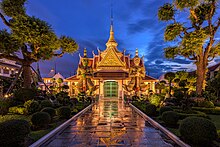Aruna (Hinduism)
| Aruna | |
|---|---|
The divine charioteer of Surya | |
 Aruna runs the chariot of Surya | |
| Planet | Uranus |
| Personal information | |
| Parents | Kashyapa and Vinata |
| Siblings | Garuda |
| Spouse | Shyeni[1] |
| Children | Sampati and Jatayu |
Arun (Sanskrit: अरुण; IAST: Aruṇa) literally means "red, ruddy, tawny", and is also the name of the charioteer of Surya (Sun god) in Hinduism.[1] He is the personification of the reddish glow of the rising Sun.[2]
Aruna is also found in Buddhism and Jainism literature and arts.[3][4] He is the older brother of Garuda. Aruna and Garuda are the sons of Vedic sage Kashyapa and his wife Vinata.[1] Shrines dedicated to Aruna, called Wat Arun, are found in Thailand.[5][6]
Mythology[]
Birth[]
Aruna is found in different, inconsistent Indian legends. In one, he was born prematurely and partially developed from an egg. According to this version, Kashyapa Prajapati's two wives Vinata and Kadru wanted to have children. Kashyapa granted them a boon.[7] Kadru asked for one thousand Nāga sons, while Vinata wanted two. Kashyapa blessed them, and then went away to a forest. Later, Kadru gave birth to one thousand eggs, while Vinata gave birth to two eggs. These incubated for five hundred years, upon which Kadru broke the eggs open and out came her 1,000 sons. Vinata eager for her sons, broke one of the eggs from which emerged the partially formed Aruna.[7] From the broken egg a flash of light, Aruna, sprang forth. He was as radiant and reddish as the morning sun. But, due to the premature breaking of the egg, Aruna was not as bright as the noon sun as he was promised to be.[8]
Vinata waited, and later the fully developed brother of Aruna named Garuda (vehicle of Vishnu) was born.[7]
In the epics[]
According to Ramayana, Aruna was married to Shyeni with whom he had two sons – Jatayu and Sampati.[9] Both of his sons played important role in the epic. Another legend about Aruna is significant in the Ramayana epic, where he takes on a female avatar Arunidevi, and has two sons who are turned into monkey commanders named Sugriva and Vali.[1]
There is a legend about Mahabharata that Surya offered Aruna and his divine chariot to his son Karna which he denied as he didn't want to rely on others to win the war like Arjuna who always depended upon Krishna.[10]
In Upanishads[]
In the Upanishadic literature such as the Brihadaranyaka Upanishad, a different sage is named Aruna whose son is also a Vedic sage named Uddalaka.[11] The term is also used for those rishis in Hindu tradition who achieve liberation through self-study.[1]
Wat Arun[]

Wat Arun ("Temple of Dawn") is a Wat (Buddhist temple) in Yai district of Bangkok, Thailand, on the Thonburi west bank of the Chao Phraya River. The temple derives its name from the Hindu god Aruna and is among the best known of Thailand's landmarks. The first light of the morning reflects off the surface of the temple with pearly iridescence.
Etymology[]
Derived words:[citation needed]
- Thai: อรุณสวัสดิ์ (pronunciation: "Arun Swat") – meaning: Good Morning
- Khmer: អរុណសួស្តី (pronunciation: "Arun Suorsdey") – meaning: Good Morning
See also[]
Citations[]
- ^ Jump up to: a b c d e Roshen Dalal (2010). Hinduism: An Alphabetical Guide. Penguin Books. pp. 39–40. ISBN 978-0-14-341421-6.
- ^ अरुण aruṇa: reddish-brown, tawny, red, ruddy (the colour of the morning as opposed to the darkness of night). Sanskrit-English Dictionary by Monier-Williams, Monier Williams (1899)
- ^ Helmuth von Glasenapp (1999). Jainism: An Indian Religion of Salvation. Motilal Banarsidass. p. 267. ISBN 978-81-208-1376-2.
- ^ John C. Huntington; Dina Bangdel (2003). The Circle of Bliss: Buddhist Meditational Art. Serindia. p. 76. ISBN 978-1-932476-01-9.
- ^ Norbert C. Brockman (2011). Encyclopedia of Sacred Places, 2nd Edition. ABC-CLIO. pp. 601–602. ISBN 978-1-59884-655-3.
- ^ Nasing, Phra Somphop; Rodhetbhai, Chamnan; Keeratiburana, Ying (2014). "A Model for the Management of Cultural Tourism at Temples in Bangkok, Thailand". Asian Culture and History. Canadian Center of Science and Education. 6 (2). doi:10.5539/ach.v6n2p242.
- ^ Jump up to: a b c George M. Williams (2008). Handbook of Hindu Mythology. Oxford University Press. pp. 62–63. ISBN 978-0-19-533261-2.
- ^ Gopal, Madan (1990). K.S. Gautam (ed.). India through the ages. Publication Division, Ministry of Information and Broadcasting, Government of India. p. 70.
- ^ Dalal, Roshen (18 April 2014). The Religions of India: A Concise Guide to Nine Major Faiths. Penguin UK. ISBN 978-81-8475-396-7.
- ^ Agarwal, Himanshu (20 August 2019). Mahabharata Retold Part-2. Notion Press. ISBN 978-1-64587-785-1.
- ^ Paul Deussen (1980). Sixty Upaniṣads of the Veda. Motilal Banarsidass. pp. 533–535. ISBN 978-81-208-1468-4.
General references[]
- Dictionary of Hindu Lore and Legend (ISBN 0-500-51088-1) by Anna Dallapiccola
- The Mahabharata
- Monier Monier-Williams: A Sanskrit-English Dictionary. Oxford U Pr, 1899.
- Robert Graves: The Greek Myths. 1955.
- Devī-Bhāgavata Purāṇa 10:13
- Characters in the Ramayana
- Hindu gods
- Solar gods
